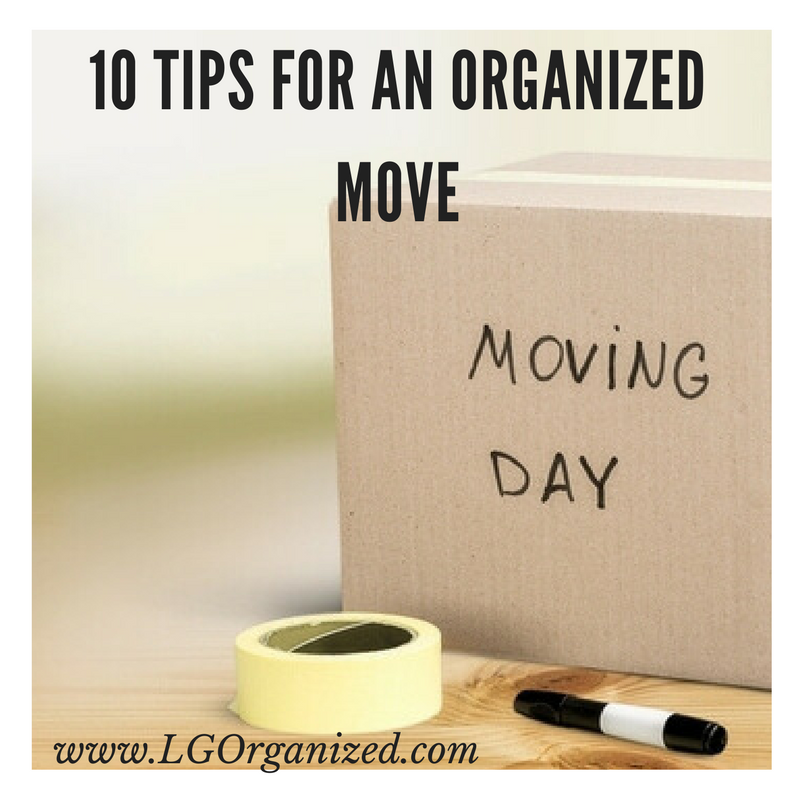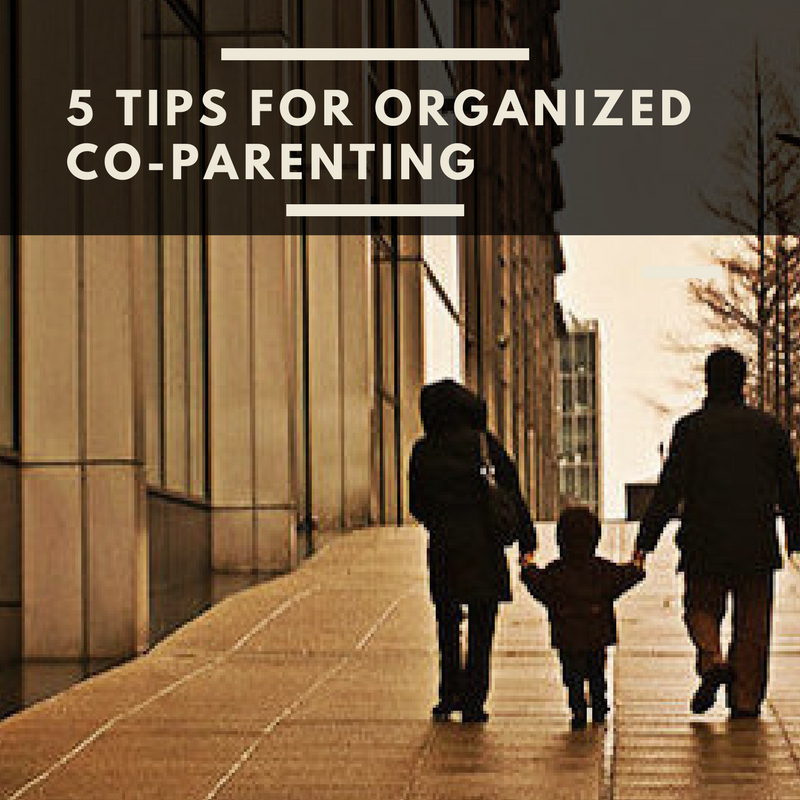10 Tips for an Organized Move

Selling a house and moving can be very stressful. A little planning and organization can help to make the process easier to navigate.
1.De-clutter and depersonalize every room and outdoor area so buyers can imagine themselves living in the house. The way you live in your home is not the way you sell your house. You’ll want to make the house look spacious and move-in ready. Start as early as possible, to give yourself enough time to sort through everything and experience the memories and emotions that may get stirred up as you touch all of your possessions. Be as ruthless as you can. Decide if the item is worth paying to move. Sort everything into categories like Keep, Toss, Donate, and Give to Family/Friends. Anything that you’ve decided will leave the house should go out the door right away. If you decide to sell some things (eBay, Craig’s List, a garage or rummage sale), do so as early as you can. If they don’t sell, you still have time to donate them.
2. Create an inventory of what you decide to keep; take pictures, especially of your most valuable pieces.
3. Pay particular attention to the kitchen, bathrooms, and closets, which are spaces that are especially appealing to buyers. Put away toiletries, as well as small appliances and cookware, and make sure exposed shelving has items neatly arranged. Don’t forget the basement; tidy up the laundry room and any utility room or storage area. Ask for help if you need it. Professional organizers, home stagers, and cleaning services are great resources for getting a house ready to sell. Maintain the house every day, so if there is a showing, you’ll always be ready.
4. Repair any cosmetic damage around your home. Patch holes in walls, and repaint rooms that need it. Clean and dust your house from top to bottom. Shampoo and vacuum all carpets. Refinish wood floors if necessary.
5. Plan what will go where in your new home. See if you can get a floor plan, and measure what you plan to bring with you. If furniture and collections won’t fit, it’s better to know now than on moving day.
6. Set up a binder or file to capture all of the details of the move. This is a key way to keep track of all of the big and little decisions and information related to your move. Store in it moving estimates, names of realtors and other professionals, and paperwork for the sale of your house. You could create a separate binder or file for the purchase of your new home, especially if you’re building or renovating it before moving in. Include names of contractors, choices of fixtures, paint, and décor, and any other information you may need regarding your new residence.
7. If you decide to pack yourself, gather or purchase moving materials. You’ll need boxes of various shapes and sizes (small boxes are good for heavy things, like books, and large boxes are good for light things, like quilts), bubble wrap, packing paper, tape, tape gun, and bold markers. You could use colorful tape pre-printed with room names. If you’re moving far away from your former house, and your contents will share space with other loads on the truck, you might also need labels with your new address for each box, to make sure that your belongings reach the right place. As you pack, number the boxes and list the box number and contents on a spreadsheet or master list stored in your binder or file.
8. Have a grab & go bag of items for immediate use on moving day. Include essential items for a couple of days, such as snacks, medications, toiletries, and a change of clothes.
9. Separate valuables and personally transport them yourself. Include anything vital, so that if the moving truck were to blow up, these items wouldn’t be on it. This may be jewelry, important documents, family heirlooms, and photos.
10. Change address with post office, driver’s license, bank/credit card/insurance/investment accounts, doctors/lawyers/accountants, utilities, subscriptions, etc. If you have children, arrange for their school records to be transferred to their new school(s).
5 Tips for Organized Co-Parenting
“There I was, a professional organizer, and I was challenged by keeping track of everything—running a business, raising two kids, planning my son’s bar Mitzvah, which was the day after the divorce finalized. I had brain fog from all I had to do and the emotions surrounding the divorce. And I thought, what about all those people who don’t have the organizing gene?” she says.
I decided to specialize in helping women stay organized through big life transitions, including divorce. I’ve helped many former couples, particularly parents, go through a divorce and co-parent more effectively.
Here are five tips for staying organized as co-parents:
1. Organize child-related finances in a way that works for both of you.
Keeping track of who paid for the school tuition or summer camp can be challenging. To avoid miscommunication—such as each parent thinking the other paid for the field trip, and discovering no one sent in a check—keep the lines of communication open, and agree ahead of time on a financial organization system that works for both of you. A good system should let you stay in contact about details and reduce money-related conflict, says Gruenberg, who was a CPA before she transitioned into professional organizing.
“If you already have an amicable relationship with your ex-spouse, and it’s easiest to summarize expenses from your checkbook and hand your co-parent a bill, by all means do that,” she says. But if your relationship isn’t amicable, or if one or both of you need a more explicit way of tracking and tallying expenses, there are many options:
- Use a spreadsheet to record the expenses you’ve agreed to share. Include categories such as extra-curricular activities, college tuition, out-of-pocket medical costs, and clothing. Keep receipts in a folder or scanned on your computer. Share this spreadsheet through a Googledoc.
- Check your bank’s website to see if there is a tool for automatically categorizing expenses. You may be able to quickly and easily download a list of expenses in each category. There are apps that do this, too, such as Mint. You can then generate and share reports with your ex.
- Utilize financial software such as Quicken or QuickBooks to keep track of parenting expenses. Have your co-parent do this, too. Once a file is set up, all of your financial transactions can categorized. You can then run many kinds of reports to share with your co-parent.
- There are also an increasing number of co-parenting calendars and apps that let you record and share expenses. Check out this post on how technology is simplifying co-parenting. Read about Supportpay.com, a site that lets you track and pay expenses online.
Another important part of staying organized financially with your ex is to know your property settlement agreement inside and out, says Gruenberg. “This will make things very clear as to who is responsible for what. It puts the onus on the paperwork and it can help to avoid conflict.”
2. Write a simple co-parenting handbook, together.
While you don’t need to agree on the same rules in separate houses, the more you can work together on some basic parenting guidelines, the easier the transitions will be for your kids, and the more harmonious your co-parenting relationship will be. Sit down with your ex-spouse and brainstorm about simple rules for issues such as discipline, homework, chores, and topics of conversation that are off-limits with the kids (such as why you divorced). Talk about expectations for pick-ups and drop-offs. What happens if someone is late? Should you do blind transitions—one person drops off and the other picks up—to avoid potential conflicts in front of the kids? How will you handle dating? When will you introduce a new boyfriend or girlfriend to your children? Discussing and then writing down your agreements can eliminate conflict later, says Gruenberg.
Just because you’re parenting separately, doesn’t mean you can’t present a unified front. This is the kind of activity a good mediator can help you with, if conflict between the two of you threatens to undermine this discussion.
Organization relates to the method you use to communicate, too, says Gruenberg. “My ex-spouse and I can’t really talk on the phone. We don’t speak the same language. (We both speak English, but what we say sounds like alien-speak to the other). I have found that texting works best for us. I continue to send follow-up messages for clarification until I get the information I need to move forward.”
3. Organize a “welcome space” for kids in your home.
Whether you’re moving into an apartment and need a space for your kids when they visit, or are staying in the house, it’s important to pay attention to your kids’ physical space. It seems obvious, Gruenberg says, but setting up a new space for your kids that accommodates their needs and interests is something that can fall through the cracks.
If you move, create a special space for them in your new home. It may just be a corner where they can hang out, but a welcoming retreat that’s just for them can go a long way to making kids feel comfortable in a new environment and a new family organization.
Equip your space with things they like. Keep some familiar things, furniture pieces, etc., from the house you used to share. This may help kids transition to being with you in a different environment. Make sure the kids have familiar toys and blankets in both parents’ homes.
4. Organize your parenting time.
It can be hard to go from spending time with your children as a couple to managing days or weekends or whole weeks alone. Having a plan for your time together can really help, even if it’s just a rough idea. And have a Plan B in mind, in case your first vision meets too much resistance or doesn’t quite work. Discuss the plan with the kids and be flexible. Do some things the kids like to do, as well as the things you have to do while they are with you.
5. Remember: Investing in divorce counseling can help with co-parenting.
By the time they get divorced, many couples have been through marriage counseling. But most don’t think about how counseling might help after a divorce, too. Family therapy can be a good idea even after the split, Gruenberg says, and help keep you organized. “One of my clients and his former partner had a son. Their relationship broke up, and they have now each entered into a new relationship,” she says.
“They went through counseling after the break-up to learn how to be co-parents. Now all of four of them get together on a regular basis and have a grand old time as a blended family.”
Whatever outside help you think you might need, feel comfortable getting it. Doing so is totally worth the investment.




